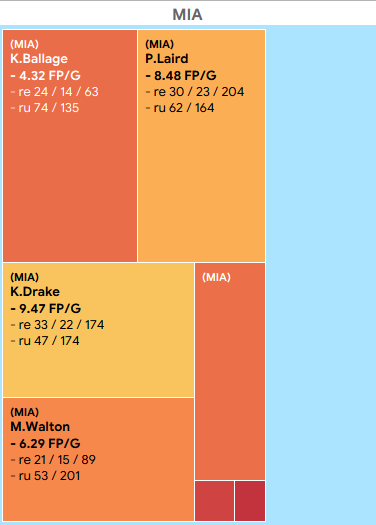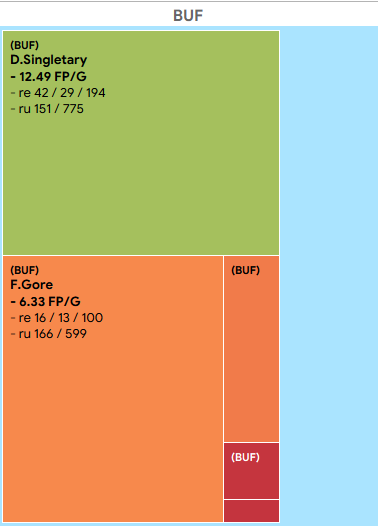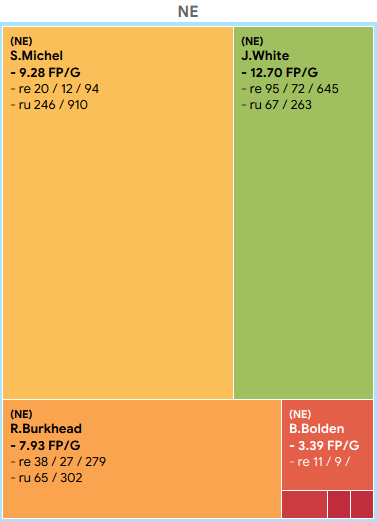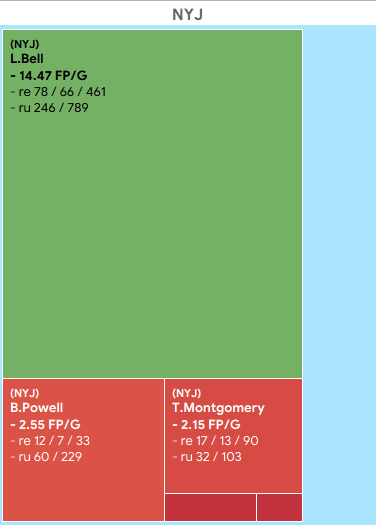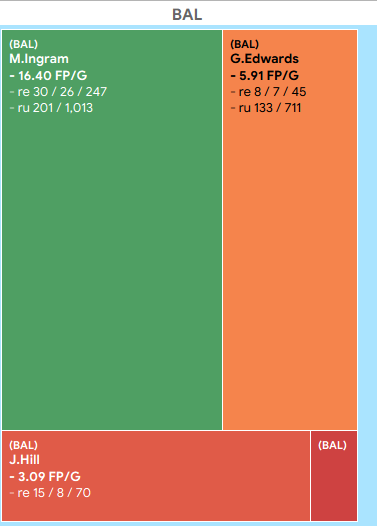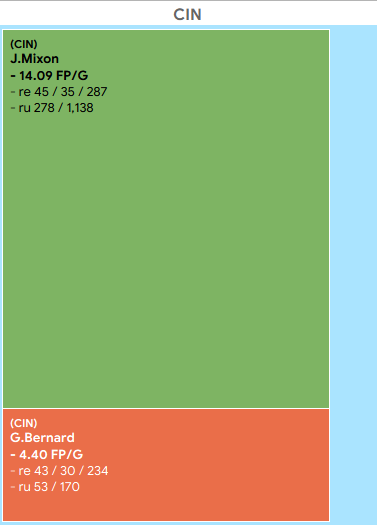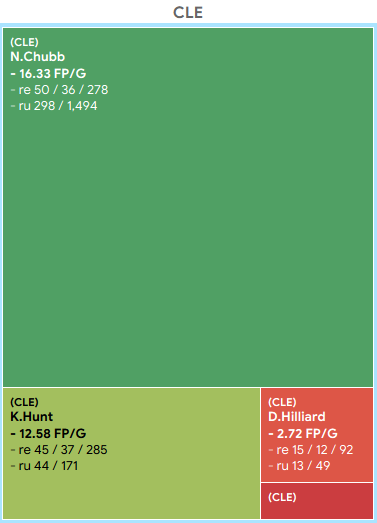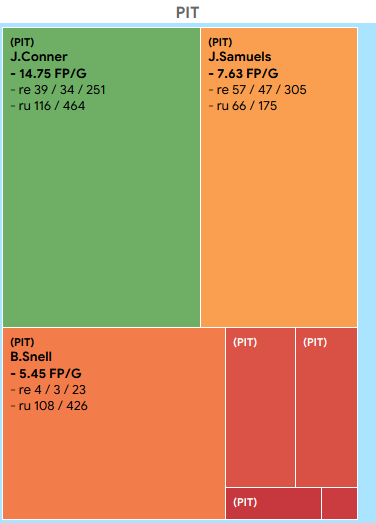Antonio Losada looks at last season's running back usage and fantasy impact for each of the 32 NFL teams. He tackles both the AFC East and AFC North franchises this time around.
We wrap up with our coverage of each of the eight NFL divisions, discussing the teams that are part of them and the running backs that were part of those teams in 2019. To present those teams and players I use a set of easy-to-read charts: treemaps. The graphics will hold all of the players of each team, the size of each box corresponding with the number of targets+carries (percentage among teammates) he saw during the season and the color related to the fantasy points per game (PPR-format leagues) he finished with at the end of the year. Also, the width of the full graphic represents how many total opportunities (tarets+carries; combining those of every rusher) were awarded to running backs by the team compared to the rest of the teams of its division (the empty space in blue to the right, the fewer targets+carries were used by rushers of such team).
Just to make things as clear as possible, I will add a little personal blurb on each team and how they performed in terms of RB usage and impact during the 2019 season. Let's dive in, this time covering the AFC East and AFC North.
Check out the other parts of this series, broken up by divisional pairs: AFC South & West, NFC East & North, NFC South & West.
Be sure to check all of our fantasy football rankings for 2025:- 2025 fantasy football rankings (redraft)
- Dynasty fantasy football rankings
- 2025 NFL rookie fantasy football rankings
- Best ball fantasy football rankings
- Quarterback fantasy football rankings
- Running back fantasy football rankings
- Wide receiver fantasy football rankings
- Tight end fantasy football rankings
- Miami Dolphins
- Just in case the treemap doesn't make it clear, let me say it: Miami's backfield was a complete mess from day one to the season's end.
- Miami gave at least 19.3% (Patrick Laird) of its opportunities to four running backs, led by Kalen Ballage's 28.2% share. At least it made sense to some extent, given none of them rewarded the team with more than 25.2% (Kenyan Drake before the trade) of its total fantasy points and fewer than 19.5% (Mark Walton).
- On a case-by-case basis, Patrick Laird was the best in FP/G yet ranked the lowest in opportunity share among those four, which should change come next season, even more knowing his catching prowess.
- Buffalo Bills
- Frank Gore was limited by his bad receiving game, which allowed Singletary to rack up a team-leading 46.5% of the opportunities over Gore's 45.1% even with the latter playing in 15 games to Singletary's 12.
- The rookie was much more efficient than the veteran, returning 54.2% of the backfield's total fantasy points and averaging more than double the FP/G of Gore.
- New England Patriots
- The Patriots backfield is a historical struggle to handle given the number of players they end using each season. There were up to seven players to log at least an opportunity in 2019, although ultimately it all came down to a three-headed monster on a near 3:2:1 rate of usage.
- Michel was thrust into the leading position with a 45.6% usage rate, but he could only get 29.2% of the backfield's points. White was much more efficient returning 40.1% of the points on just a 30% opportunity share.
- Burkhead, although very limited in chances (17.5% opportunity share) was still able to contribute 18.1% of the points and averaged virtually the same FP/G as Michel while showing much better pass-catching traits.
- New York Jets
- If we're honest, Bell's season was saved just because of the incredible volume he saw weekly (69.9% opportunity share). Had it not been for that, his numbers would look way worse than they do now.
- Powell and Montgomery shared the crumbs left by Bell with 15.8% and 11.7% opportunity rates respectively, but they both were mediocre and could only amount to 23.3% of the total points combined, while Bell returned 75.2% of them.
- Baltimore Ravens:
- I expected Edwards and Hill to have a stronger presence in this offense before the start of the season, but given how good Ingram has been it made sense leaving those two a bit out of work.
- Ingram racked up 60.2% of the backfield's total points while being given 50.7% of the chances, which is an incredible return.
- Edwards doubled Hill in both usage and production, so nothing to question about Baltimore's decisions this year.
- Cincinnati Bengals
- Nice to see a good old two-man backfield these days... although Mixon ran all over Bernard in 2019 and that's saying a lot considering the low year the former had.
- Mixon was given 75.8% of the backfield's opportunities and although he returned 73.6% of the fantasy points he should have done more than averaging 13.3 FP/G as he did this season in 16 games.
- Bernard was super limited (24.2% opportunity rate) and couldn't even reach Mixon's targets on the year, let alone the rushing attempts.
- Cleveland Browns
- For all the good Nick Chubb did, I'm completely blown away but how great Kareem Hunt's short run with the Brown was. In only eight games he was able to return 22.2% of the total points the backfield tallied over the year, that is, 14.5 FP/G.
- As the no. 1 rusher of the team from Week 1, Chubb finished with a massive 73.7% of the opportunities going his way and his fantasy points per game were ultra-boosted by a great eight touchdowns scored on the ground.
- Pittsburgh Steelers
- Injuries (at the very least) shook the Steelers backfield and whole offensive scheme, which saw three tailbacks log at least 21.5% of the opportunities. Conner retained his leading role, though racking up 36.8% of them and returning 45% of the total fantasy points with a great set of performances.
- Samuels was given more chances than Snell Jr. and it paid off, as the former got 30% of the backfield's fantasy points himself in 14 games scoring both receiving and rushing touchdowns.
 RADIO
RADIO








